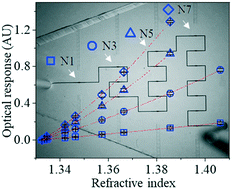A 3D-cascade-microlens optofluidic chip for refractometry with adjustable sensitivity†
Abstract
Refractive index (RI) sensing as a label-free and non-invasive method has been playing an important role in industrial metrology, biochemical detection, and environmental analysis. Due to the combined advantages of microoptics and microfluidics, optofluidic RI sensors have attracted growing interest. Despite a variety of prototypes of optofluidic RI sensors, comprehensive improvement in sensitivity, detection range, fabrication procedures and cost can still bring substantial benefits to the field. In this work, we fabricated a 3D-cascade-microlens optofluidic chip (3DCMOC) for RI sensing. Two-photon stereolithography was employed to fabricate the chip mold, with which the 3DCMOC could be easily manufactured via mold replication. By virtue of integrating four detection channels configured with different numbers (1, 3, 5, and 7) of cascaded microlenses within the 3DCMOC, adjustable sensitivity for RI sensing has been demonstrated through measuring standard sucrose solutions. It was found that the seven-microlens configuration achieved an excellent sensitivity (mean: 21 ± 5 AU·RIU (refractive index unit)−1) and resolution (mean: 3.8 × 10−5 ± 0.9 × 10−5 RIU) at a cost of a narrow linear dynamic range (LDR, 1.3326–1.3548). In contrast, the single-microlens configuration led to an extended LDR (1.3326–1.5120 tested) despite the lower sensitivity (mean: 2.6 ± 0.2 AU·RIU−1) and resolution (mean: 1.5 × 10−4 ± 0.1 × 10−4 RIU). Furthermore, the use of the 3DCMOC was investigated via real-time salinity sensing and analysis of urine specific gravity.



 Please wait while we load your content...
Please wait while we load your content...